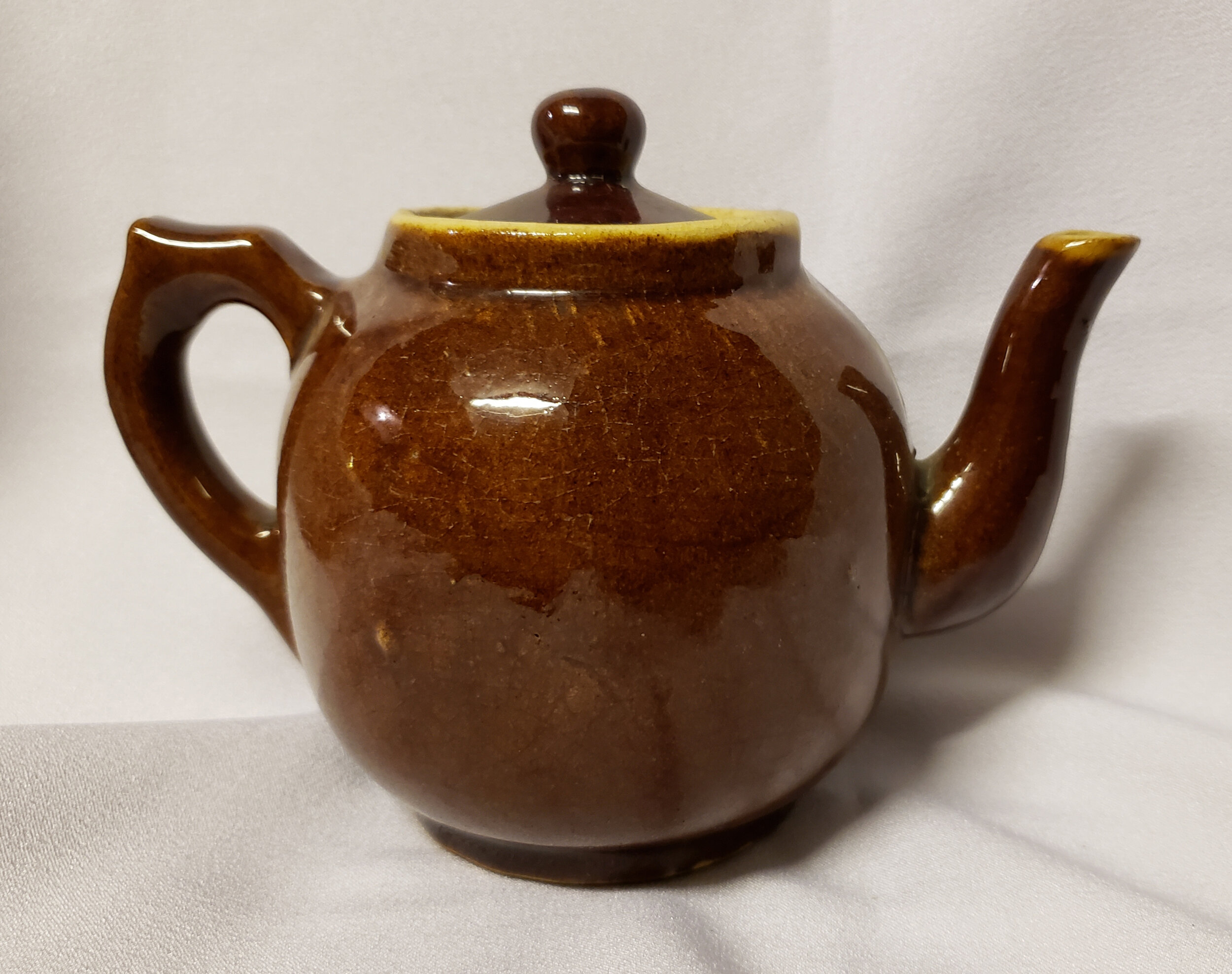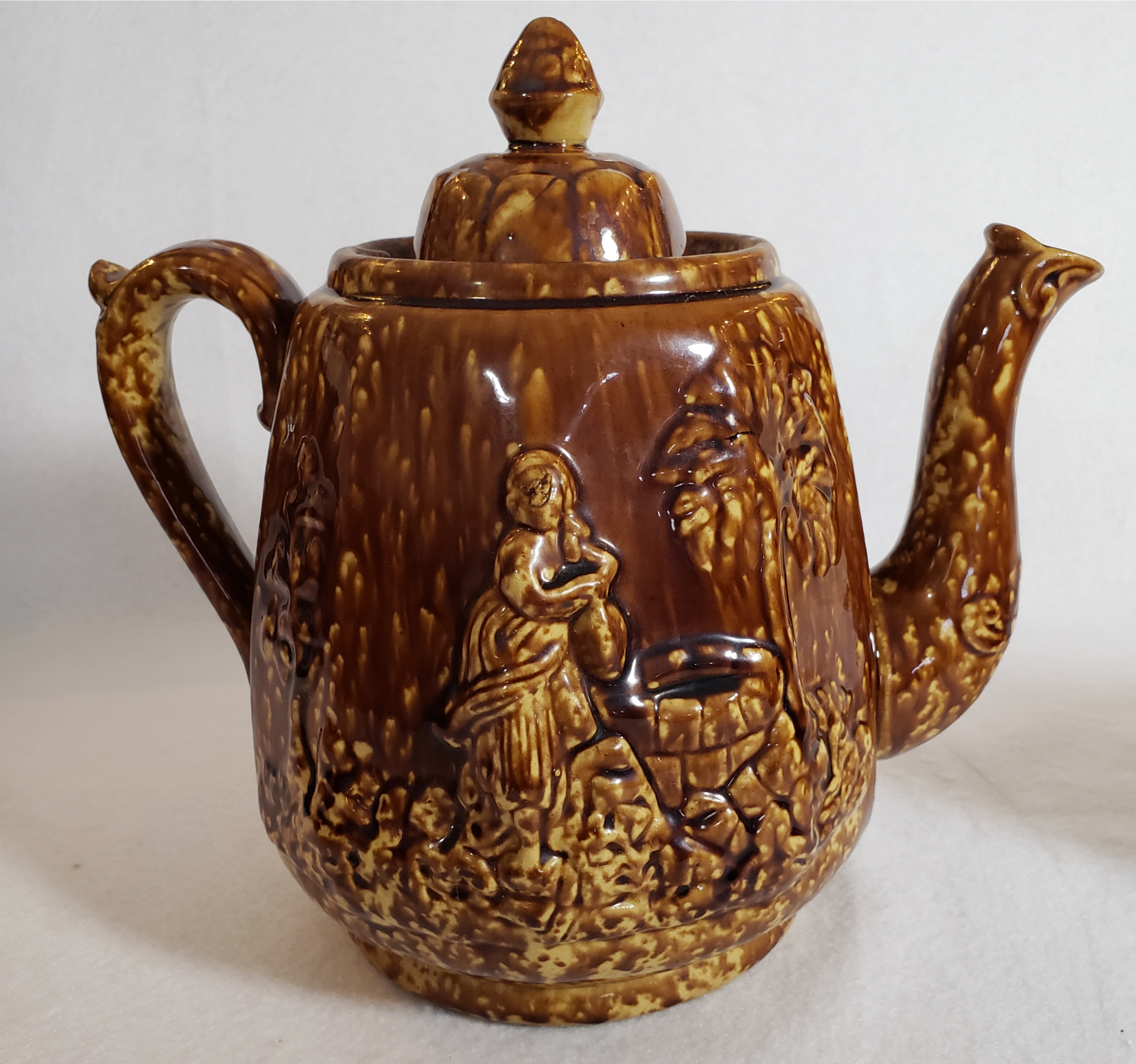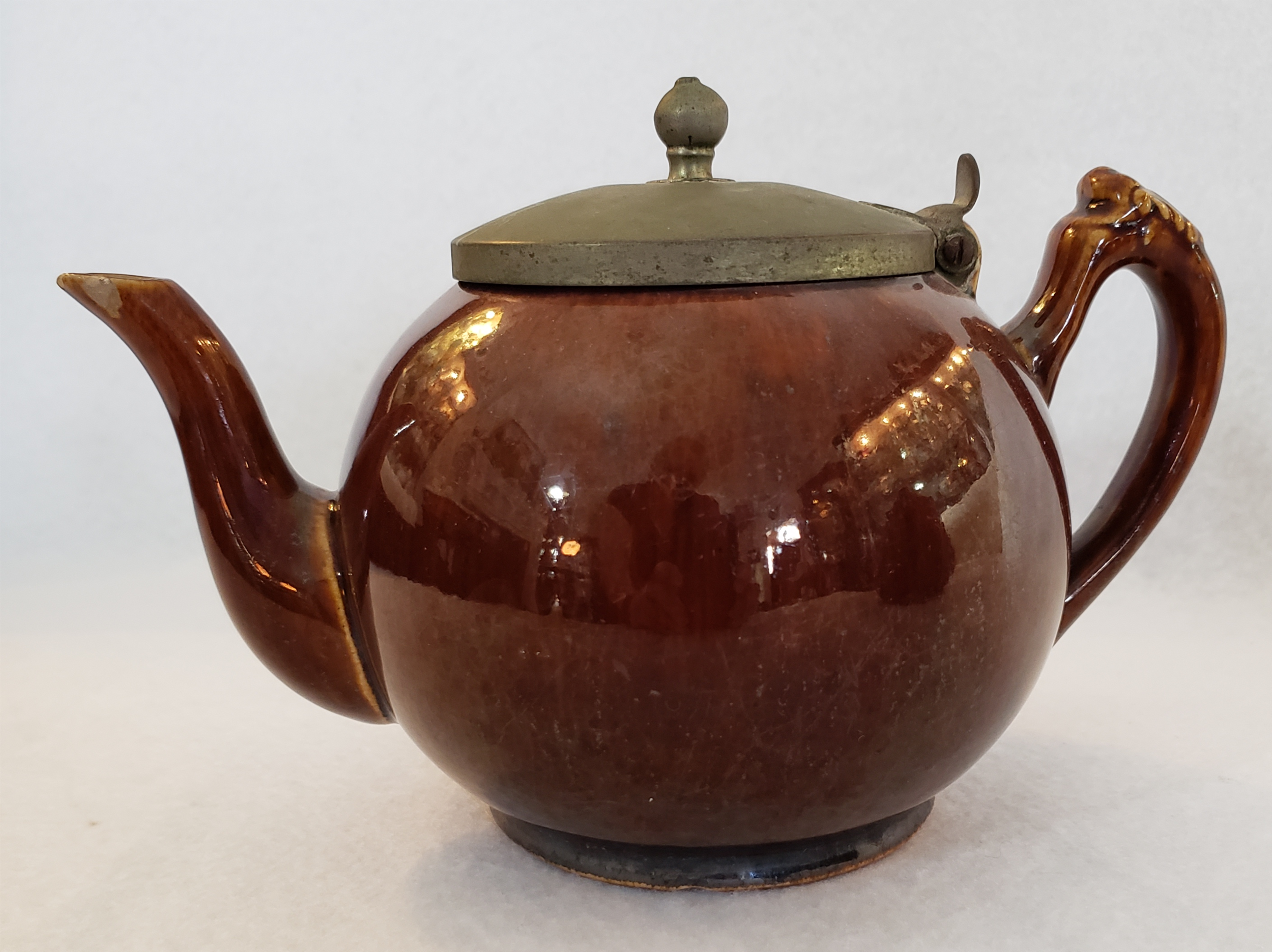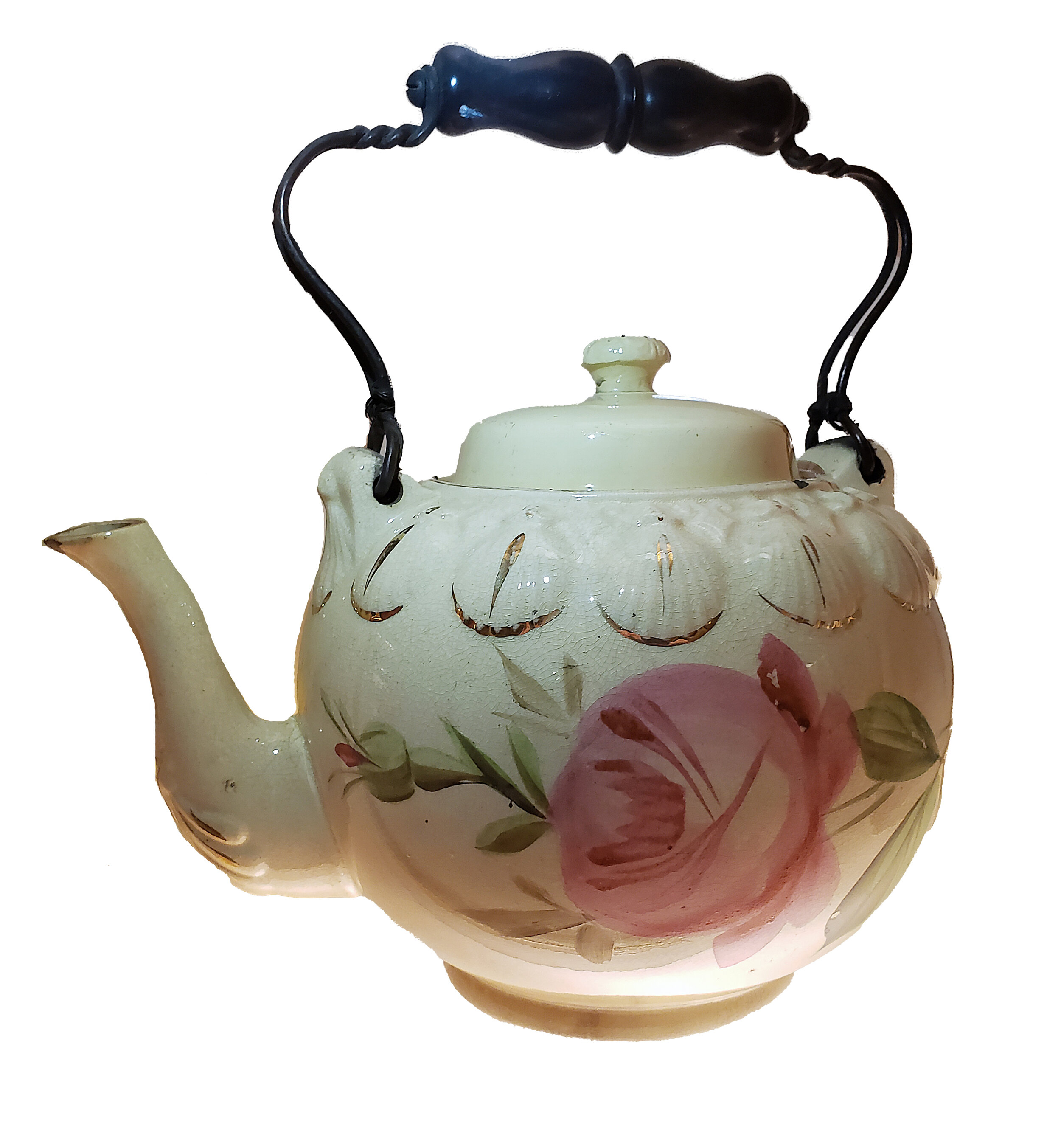Rockingham and Yellowware
TITLE: Rockingham
MAKER: James Bennett (attributed)
DATE: 1850-1900
COLLECTION: Museum of Ceramics/Ohio History Connection H242
Referred to as Rockingham ware, Rockingham, is the manganese glaze on earthenware. In East Liverpool, the glaze was applied over a yellowware body. The glaze is applied or poured on the ware and the item is fired in the kiln. Rockingham produces variations on a brown color depending on the intensity of the glaze.
James Bennett was the first potter in the East Liverpool area who marketed his ware outside the local area for commercial gain. From his pottery on the banks of the Ohio river he sold his wares, primarily by boat, to communities down the Ohio to the Mississippi and points West.
Bennett often used the popular “Rebekah at the Well” motif on Rockingham ware. Other motifs can be seen in the exhibit.
In the Americas the name Rockingham became a marketing tool rather than a production process. (Claney, 2004).
TITLE: Rockingham
MAKER: Baggott Brothers Pottery (attributed)
DATE: 1853-c.1897
COLLECTION: Museum of Ceramics/Ohio History Connection H265
American production of Rockingham would migrate to whitewares by the latter part of the 19th century although some potteries continued making Rockingham into the 20th century. The Baggot Brothers pottery was one of the earliest in the East Liverpool Pottery District. A portion of the Goodwin/Baggot Pottery still exists on East Liverpool’s Second Street. This pottery, like the Museum of Ceramics, is now an Ohio History Connection site
Tea Recipe:
CAMOMILE, HONEY & VANILLA CIDER: In small pan, combine 2 cups apple cider, 6 allspice berries, 2 whole cloves, and a cinnamon stick, cook on low for 8 – 10 minutes until fragrant and simmering gently. Remove mulled cider from stove, add 2 Twinings Herbal Chamomile, Honey & Vanilla teabags, let steep for 4 – 5 minutes. Remove bags, strain cider into 2 cups. (Twinings).
TITLE: Rockingham
MAKER: unknown
DATE: before 1900
COLLECTION: Museum of Ceramics/Ohio History Connection HC1793
The intensity in color of the Rockingham glaze was determined by its recipe. Manufacturers kept journals with these recipes. The Museum of Ceramics has several of these early journals that include the amounts and types of materials used to produce both the ware and the glaze. In one journal, William Vodrey notes that an incorrect amount of a certain “ingredient” had turned the ware unusable and caused a failure in production. (Vodrey, 1839).
Tea Trivia:
Tea sommeliers are a thing. The Palais de Tay in Paris or the Academy of Tea in the United Kingdom teaches classes and offer certification. A tea sommelier is a person who helps restaurants and hoteliers understand and pair the correct food with the correct tea, much the same way as a wine sommelier does. (Chamberlain, 2019).
TITLE: Yellowware
MAKER: Frederick, Shenkle, Allen and Company (attributed)
DATE: 1881-1888
COLLECTION: Museum of Ceramics/Ohio History Connection H 222
A note attached to this teapot states, “made by Robert Webb Sr. Shenkle and Frederick Pottery Co. River Road.”
The clay along the Ohio River near the small village of what is now East Liverpool was ideal for making Yellowware. Yellowware became the base for the majority of the Rockingham and other utilitarian wares produced by the earliest East Liverpool potteries.
Tea Trivia:
Sassafras tea, with its root beer-like flavor, is made from the root bark of the sassafras tree. Often spices such as cinnamon, ginger, and cloves are added to the brew. Once a household staple, sassafras tea is now highly regulated by the government because it contains safrole, a substance known to stimulate cancer growth in laboratory animals. Until more research is completed, health experts recommend that tea-lovers purchase only safrole-free sassafras tea and limit their intake. (Link, 2019).
TITLE: Basket Weave
MAKER: C.C. Thompson Company (attributed)
DATE: ca late 19th century
COLLECTION: Museum of Ceramics/Ohio History Connection H263
Little is known about this basket weave yellowware teapot. There is no pottery or production trademark. A similar teapot appears in an early advertisement for the C.C. Thompson Pottery.
Tea Recipe:
EARL GREY FRENCH 75 (cocktail): place 4 Twinings Earl Grey teabags and ½ cup gin in a jar, cover and let stand for 4 to 5 hours. Remove and squeeze bags. In a small pan, medium heat, stir together 3 Tbs water, 3 Tbs honey, 1 tsp lemon zest, and one sprig of rosemary. Simmer 1 to 2 minutes until honey is dissolved and let cool. Add all ingredients plus 3 Tbs lemon juice to cocktail shaker and fill with ice. Cover and shake until shaker is frosty and very cold. Pour into 2 glasses, top each with ¼ cup Prosecco (or sparkling wine) and serve. (Twinings).
TITLE: Rockingham
MAKER: unknown
DATE:
COLLECTION: Museum of Ceramics/Ohio History Connection HC1515
The unusual mark on the base of this piece has not been attributed.
TITLE: Rockingham
MAKER: Baggott Brothers
DATE: 1853-1900
COLLECTION: William and Donna Gray
The Baggott Brothers, William and Samuel, were some of the earliest potters to produce ware in East Liverpool. In 1870, they, along with one other company, stood with workers against a group of potteries that had banded together to fix prices and wages. Workers struck against the proposal but in 1872 there was a 10% reduction in pay and in 1874 an additional reduction of 12 1/2%. Workers would strike again, and although they would finally accept the reduction, the owners agreed that when the economy improved wages would return, or rise above, the rates of earlier times. (Gates, 1984).
Tea Trivia:
From William Ewart Gladstone we hear: “If you are cold, tea will warm you; if you are too heated, it will cool you; If you are depressed, it will cheer you; If you are excited, it will calm you.” (Top, 2020).
TITLE: Rockingham - Chinese
MAKER: C.C. Thompson (attributed)
DATE:
COLLECTION: Museum of Ceramics/Ohio History Connection HC1792
A highly detailed Chinese theme with smooth Rockingham glaze. The relief is added to a master mold. Over time, the relief definition diminishes, and a new relief is added to the master shape. This example is attributed to the C.C. Thompson Company with the unusual base mark pictured to the right.
Each pottery had it’s own recipe for Rockingham glaze in various varieties from light browns to dark or black. An 1850 entry in the William Vodrey “recipe” book states that the Rockingham glaze consisted simply of 68 quarts of yellow glaze with 17 quarts of manganese ground added to it. Later entries show a more detailed and advanced composition for the different Rockingham glazes including, in 1864, an attempt to replicate Daniel Bennett’s Rockingham glaze recipe. (Vodrey, 1839).
TITLE: Rockingham
MAKER: Unknown
DATE: late 19th century
COLLECTION: Museum of Ceramics/Ohio History Connection HC 1797
This teapot has a high lustre, smooth, uniform Rockingham glaze over a yellowware base. Often the interior was not, or not uniformly, glazed with Rockingham. Wares produced from the local clays were porous and, unless fully glazed inside and out, would retain the odors and colors of the food heated or stored inside. Even glazed ware, if it was crazed, would discolor and smell. In the early 20th Century the Hall China Company would pioneer a process to seal the ceramic product.
The undecorated Rockingham wares were popular toward the end of the 19th Century (Claney, 2004)..
TITLE: Rockingham - Rebekah at the Well
MAKER: Croxall and Cartwright
DATE: 1856-1888
COLLECTION: William and Donna Gray
Thomas Croxall arrived in East Liverpool in 1844. When his father and brothers, all skilled potters, arrived they purchased the James Bennett pottery. The Bennett’s had moved their manufacturing to Pittsburgh, Pennsylvania. In 1852, the pottery was destroyed in a flood of the Ohio River. In 1856, Thomas and John Croxall, along with Jonathan Kinsey, joined with Joseph Cartwright and purchased the pottery of Ball and Mears. The company of Croxall and Cartwright would emerge after Thomas Croxall and Jonathan Kinsey left the company in 1858/1859. Despite the American Civil War, by 1876 Croxall and Cartwright would grow into one of East Liverpool’s largest potteries.. (Gates, 2009).
TITLE: Rockingham
MAKER: Manley & Cartwright (attributed)
DATE: 1864-1880
COLLECTION: Museum of Ceramics/Ohio History Connection H216
Holland Manley, a Staffordshire potter and William Cartwright purchased the Webster pottery in 1864 and produced Yellowware and Rockingham. (Gates, 2009).
TITLE: Rockingham
MAKER: “Eagle” Pottery Works (attributed)
DATE: 1853 - c.1896
COLLECTION: Museum of Ceramics/Ohio History Connection H262
The Baggott Brothers pottery was called the “Eagle” pottery works. Many of the East Liverpool companies named their manufacturing facilities with a “nickname.” This name could indicate a location, be in remembrance of a person or event, or as in some cases, the names had a duplicitous meaning. The Baggott Brothers “Eagle” pottery could have been a signal to the world that the items were produced in America and that America was becoming a powerful ceramics producer. However, others, such as the “Dresden” potteries, may have indicated a location in East Liverpool but also attempted to lead the purchaser to believe that the item was manufactured in Dresden, Germany.
TITLE: Rockingham
MAKER: J. W Croxall
DATE: 1894-1914
COLLECTION: William and Donna Gray
This teapot appears with one of the few attributing marks found on Rockingham during this period. Marks on items from the early to later 19th century are rarely seen. The bottom of this pot show the bright yellow, natural color of the clay.
TITLE: Rockingham
MAKER: Josiah Thompson (attributed)
DATE: 1868-1869
COLLECTION: William and Donna Gray
Josiah Thompson, was a successful dry goods merchant who would encourage and finance his son, Cassius C. Thompson to persevere in the pottery industry. In 1868 Cassius entered into a partnership with J. T. Herbert and together they opened a small pottery called Thompson and Herbert making Rockingham and “Queensware”, a term used for cream colored or common clay ware. In 1870, Josiah Thompson would buyout Herbert’s interest in the company. The C.C. Thompson and Company pottery would endure until 1938. (Gates, 2009).
Daniel Edward McNicol was a well established potter in the East Liverpool District. He was in business as the McNicol, Burton and Company from 1869 to 1892. In 1892 McNicol would become president of the company and the company was incorporated. The D.E. McNicol company made Rockingham and Yellowware until 1927 making it the last of the East Liverpool district potteries to use the local clays (Gates, 2009).
TITLE: Rockingham
MAKER: D. E. McNicol Pottery Company
DATE: 1892-1928
COLLECTION: William and Donna Gray
A pair of Rockingham teapots, the pineapple shape on the left, and the carnation shape below, produced by the D.E. McNicol Pottery Company.
TITLE: Speckled Yellowware
MAKER: Unknown
DATE: Late 19th Century
COLLECTION: Museum of Ceramics/Ohio History Connection H221 and HC1014
Unusual blue and brown speckles over a yellow body and a smaller example with a darker speckled glaze.. The amount of glaze used, and the manner it was applied to the ware, determined the outcome after firing. Some pieces were fully dipped in the glaze while others were brushed or spattered. Many show yellowware in small areas, possibly where the potter held the item as it was dipped and others were completely covered in a combination of dipping and brushing to produce a uniform high gloss finish. (Brewer, 1996).
TITLE: Rockingham
MAKER: Unknown
DATE:
COLLECTION: Museum of Ceramics/Ohio History Connection HC1799
Similar in shape to a teapot by the C.C Thompson Company exhibited in Gallery 1, it is possible that these teapots were made from the same or similar molds during the transition from Rockingham and yellowware to whiteware. Popular shapes were also reproduced, with similar but slightly different designs, by competing potteries, to attract customers to their wares.
Tea Trivia:
Leo Tolstoy said of his process, “I must drink lots of tea or I cannot work. Tea unleashes the potential which slumbers in the depth of my soul.” (Top, 2020).
TITLE: Rockingham
MAKER: Unknown
DATE: Late 19th Century
COLLECTION: Museum of Ceramics/Ohio History Connection HC 1795
Possible potters mark
TITLE: Rockingham - Rebekah at the Well
MAKER: Josiah Thompson (attributed)
DATE: 1868-1869
COLLECTION: William and Donna Gray
The themed teapot of Rebekah at the Well was a literal translation of the “Arabic” theme found on English Rockingham pitchers. It is believed that Bennett’s designer Charles Coxon copied the motif and renamed it for the American market. Rebekah at the Well, especially on a teapot, symbolized the role of women in the home. It was also produced when religion in the home was a very prevalent component of society. There were twice as many Rebekah at the Well teapots produced than teapots with floral or foliate themes.
In society, there were more Rebekah at the Well teapots in urban lower-class homes and more Rebekah at the Well pitchers used in middle-class homes. In middle-class society there was a distinction between Rockingham and whiteware, and their prominence in daily use. Rockingham ware was used at more casual times during the day such as for serving tea and behind the scenes in the kitchen. Whiteware was used for dining and formal settings when everything needed to be at its best and would be seen by family and visitors. (Claney, 2004).
TITLE: Yellowware
MAKER: Knowles, Taylor & Knowles Company
DATE: c 1871
COLLECTION: Museum of Ceramics/Ohio History Connection
A pair of molded yellowware teapots, or kettles, with shell decoration, hand painted floral design, and metal handles. A similar teapot in whiteware, by the Cartwright Brothers Pottery, is depicted in Gallery 2.
Mary Brewer’s, Collectors Guide to Rockingham the Enduring Ware, includes a Rockingham example of these kettles. As potteries transitioned from different glazes and base wares, demand for certain styles and designs did not necessarily diminish. This design seems to have endured through the transition. Other designs, such as Rebekah at the Well, did not transition well and few were made (Brewer,1996, Claney, 2004)..
TITLE: Yellowware
MAKER: unknown
DATE:
COLLECTION: Museum of Ceramics/Ohio History Connection HC 219
A small blue glazed yellowware teapot (lid missing). The shell theme is seen in the transition from yellowware to whiteware products, as seen above and in Gallery 2.
Production of Rockingham and yellowware continued throughout the 19th Century and into the early 20th Century. Production declined as whiteware and stronger, less porous ceramics were developed and gained in popularity and demand. American tastes in dinnerware had changed. Homemakers preferred the more elegant-looking whiteware pieces for their dinner tables. (Claney, 2004).
































